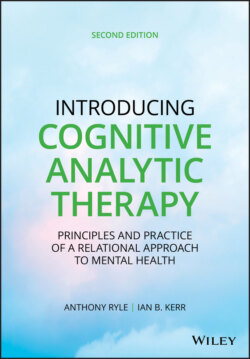Читать книгу Introducing Cognitive Analytic Therapy - Anthony Ryle - Страница 59
Cognitive Psychology and Cognitive Therapy
ОглавлениеOne important early influence in the development of CAT was personal construct theory (Kelly, 1955), an approach which challenged both psychoanalytic and behavioral assumptions and which, especially if linked with social constructivism, goes some way toward acknowledging the specifically human, cultural influences on personality. The dominant cognitive theory of the last decades, however, influenced by artificial intelligence research and computer metaphors, has been concerned with information processing and storage. In our view this is still largely the case, although some authors began to show an increasing interest and awareness of the effects of early interpersonal experience and of the importance of (social) meaning in development and in therapy (see Brewin, 1988; Salkovskis, 1996; Safran & McMain, 1992; Stiles, 1997; Perris, 2000). An important contribution of these cognitive and behavioral theories to the CAT model was their demonstration of the value of analyzing and describing sequences (for example, linking behaviors to outcomes, cognitions to emotions) and their demonstration that many problems can be understood without postulating unconscious forces. The cognitive component of CAT theory was derived initially from the work with repertory grids and, to a degree, from personal construct theory. Miller, Galanter, and Pribram (1960) and Neisser (1967) were also significant influences. In Ryle (1982), the Procedural Sequence Model (PSM) was compared in some detail to Beck's model of cognitive therapy (Beck, 1976), to Roth's model of learned helplessness (Roth, 1980), to Rehm's model of depression (Rehm, 1977), to Rotter's model of generalized expectancies (Rotter, 1978), to Forstelling's attribution theory (Forstelling, 1980), and to Bandura's model of self‐efficacy (Bandura, 1977). In terms of practice, the use of patient self‐monitoring was derived from Beck and became one important aspect of the reformulation process, but in CAT the focus of attention was shifted as soon as possible from symptoms to procedures.
Later developments in cognitive‐behavior therapy (CBT), for example the work of Guidano (1987) or Neisser (1993) focusing on a concept of self, and those stressing the importance of early interpersonal experience and of attachment patterns, including in relation to dissociation (see Gumley & Schwannauer, 2006; Liotti et al., 2008; Perris, 2000), or interpersonally‐derived “schemas” (Young et al., 2003), or even those seeing the self as a set of information processing systems (Prescott, 2015), show some convergences with CAT. This would include clinical work noting and addressing ways in which so‐called “therapy interfering behaviors” or “resistance” may arise (Leahy, 2001). These have to some extent shifted attention to higher level functions and more complex disorders but important differences remain, as will become clear in later chapters. Notably, such approaches still lack, in our view, a clear and coherent means of understanding and effectively addressing “therapy interfering behaviors,” “resistance,” or therapeutic challenges and ruptures in a productive and non‐blaming way (see also Chapter 9).
The early CAT model (PSM) therefore resembled cognitive ones but differed essentially in that the unit of observation—the procedural sequence—involved linking together environmental, mental, and behavioral phenomena and their implicit underlying relational origins. The level of address in CAT is on whole‐person Self processes and structures understood in developmental and contextual terms, whereas CBT remains usually focused on particular beliefs, symptoms, or behaviors and pays little attention to development or structure, or to socio‐cultural context. Some important differences deriving from these and as manifest in the clinical practice of CBT and CAT are further considered in Chapter 9.
